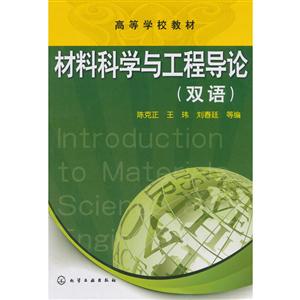材料科学与工程导论-(双语)
本书特色
[
本教材是材料科学与工程导论的双语教材,以现行“材料科学与工程导论”课程标准为依据,结合中文教材,以国外原版教材做参考并根据国内的教学情况及材料科学研究的*进展对教材内容进行适度的整合。全书共分9章,具体内容包括:绪论,固体材料的结构,常用工程材料(高分子材料、金属材料、陶瓷材料和复合材料)的结构、力学性能、成分、加工工艺以及应用前景,常用工程材料的化学性能(耐腐蚀性能)和物理性能(电、磁、热和光学性能)以及新型材料(生物材料、纳米材料和智能材料)的介绍等内容。 本教材可供大专院校材料科学与工程及相关专业师生使用,也可供从事材料科学与工程研究、开发及管理的人员参考。
]
目录
Chapter 1Introduction1
Learning Objectives1
1��1Historical Perspective1
1��2What is Materials Science and Engineering?2
1��3Why Study Materials Science and Engineering?5
1��4Classification of Materials5
1��5Advanced Materials9
1��6Modern Materials’ Needs10
References11
Chapter 2The Structure of Crystalline Solids13
Learning Objectives13
2��1Atomic Structure and Interatomic Bonding13
2��1��1Fundamental Concepts14
2��1��2Bonding Forces and Energies14
2��1��3Atomic Bonding in Solids16
2��2Crystal Structures22
2��2��1Fundamental Concepts22
2��2��2Metallic Crystal Structures and Crystal Systems23
2��2��3Crystallographic Points,Directions,and Planes30
2��2��4Crystalline and Noncrystalline Materials37
2��3Imperfections in Solids40
2��3��1Point Defects in Metals40
2��3��2Dislocations—Linear Defects43
2��3��3Interfacial Defects44
2��3��4Bulk or Volume Defects46
References48
Chapter 3Polymer Materials49
Learning Objectives49
3��1Polymer Structures49
3��1��1Introduction49
3��1��2Fundamental Concepts49
3��1��3Polymer Molecules50
3��1��4Designation of Polymers50
3��1��5Commonly Used Polymers51
3��1��6The Chemistry of Polymer Molecules58
3��2Crystallization,Melting and Glass Transition Phenomena in Polymers65
3��3Mechanical Properties of Polymers66
3��3��1Stress�睸train Behavior67
3��3��2Macroscopic Deformation68
3��3��3Viscoelastic Deformation70
3��4Polymer Types71
3��4��1Plastics71
3��4��2Elastomers72
3��4��3Fibers73
3��4��4Miscellaneous Applications Coatings73
3��5Processing of Polymers74
3��5��1Polymerization75
3��5��2Polymer Additives76
3��5��3Forming Techniques for Plastics78
3��5��4Fabrication of Elastomers80
3��5��5Fabrication of Fibers and Films81
References84
Chapter 4Metallic Materials85
Learning Objectives85
4��1Mechanical Properties of Metals85
4��1��1Introduction85
4��1��2Tensile Test86
4��1��3Hardness Testing90
4��2Dislocations and Strengthening91
4��2��1The Role of Dislocations91
4��2��2Work Hardening93
4��2��3Grain Size Strengthening93
4��2��4Alloy Hardening94
4��3Failure96
4��3��1Introduction96
4��3��2Fundamentals of Fracture97
4��3��3Ductile Fracture97
4��3��4Brittle Fracture98
4��3��5Fracture Mechanics in Design99
4��3��6Fracture Toughness100
4��3��7Fatigue101
4��3��8Creep101
4��4Phase Diagrams and Phase Transformations in Metals102
4��4��1Introduction102
4��4��2Phase Diagrams103
4��4��3Phase Transformations107
4��5Applications and Processing of Metal Alloys108
4��5��1Introduction108
4��5��2Types of Metal Alloys109
4��5��3Fabrication of Metals113
4��5��4Thermal Processing of Metals115
References120
Chapter 5Ceramic Materials123
Learning Objectives123
5��1Structures and Properties of Ceramics123
5��1��1Introduction123
5��1��2Ceramic Structures123
5��1��3Mechanical Properties of Ceramics127
5��2Application and Processing of Ceramics129
5��2��1Types and Applications of Ceramics129
5��2��2Fabrication and Processing of Ceramics131
References136
Chapter 6Composite Materials137
Learning Objectives137
6��1Introduction137
6��2Particle�睷einforced Composites138
6��2��1Large�睵article Composites139
6��2��2Dispersion�睸trengthened Composites140
6��3Fiber�睷einforced Composites140
6��3��1The Fiber Phase140
6��3��2The Matrix Phase141
6��4Polymer�睲atrix Composites142
6��4��1Glass Fiber�睷einforced Polymer(GFRP)Composites142
6��4��2Carbon Fiber�睷einforced Polymer(CFRP)Composites143
6��4��3Aramid Fiber�睷einforced Polymer Composites143
6��5Metal�睲atrix Composites145
6��6Ceramic�睲atrix Composites146
References149
Chapter 7Corrosion and Degradation of Materials150
Learning Objectives150
7��1Introduction150
7��2Corrosion of Metals150
7��2��1Electrochemical Considerations151
7��2��2Corrosion Rates153
7��2��3Passivity153
7��2��4Environmental Effects153
7��2��5Forms of Corrosion154
7��2��6Corrosion Environments158
7��2��7Corrosion Prevention159
7��3Corrosion of Ceramic Materials159
7��4Degradation of Polymers160
7��4��1Swelling and Dissolution160
7��4��2Bond Rupture160
7��4��3Weathering161
References163
Chapter 8Electrical/Thermal/Magnetic/Optical Properties of Materials164
Learning Objectives164
8��1Introduction165
8��2Electrical Properties of Materials165
8��2��1Metals and Alloys166
8��2��2Semiconductors167
8��2��3Ionic Ceramics and Polymers170
8��3Thermal Properties of Materials170
8��3��1Heat Capacity170
8��3��2Thermal Expansion171
8��3��3Thermal Conductivity172
8��3��4Thermal Stresses172
8��4Magnetic Properties of Materials174
8��4��1Diamagnetism,Paramagnetism and Ferromagnetism174
8��4��2Antiferromagnetism and Ferrimagnetism177
8��4��3The Influence of Temperature on Magnetic Behavior179
8��4��4Domains,Hysteresis and Magnetic Anisotropy179
8��4��5Superconductivity181
8��5Optical Properties of Materials186
8��5��1Interaction of Light with Matter186
8��5��2Atomic and Electronic Interactions187
8��5��3Refraction,Reflection,Absorption and Transmission190
8��5��4Opacity and Translucency in Insulators192
8��5��5Applications of Optical Phenomena192
References197
Chapter 9Biomaterials/Nanomaterials/Smart Materials198
Learning Objectives198
9��1Biomaterials198
9��1��1Definition of Biomaterials199
9��1��2Performance of Biomaterials202
9��1��3Brief Historical Background203
9��2Nanotechnology and Nanomaterials205
9��2��1Introduction205
9��2��2Examples of Current Achievements and Paradigm Shifts209
9��3Smart Materials214
9��3��1Introduction214
9��3��2Shape Memory Alloys215
9��3��3Applications of Smart Materials219
Reference220
封面

书名:材料科学与工程导论-(双语)
作者:陈克正
页数:220
定价:¥39.0
出版社:化学工业出版社
出版日期:2018-08-01
ISBN:9787122117588
PDF电子书大小:38MB 高清扫描完整版
